2020 MV Agusta Brutale 1000 RR
MV Agusta tames the Brutale, all 208 hp of it
If you were expecting a warmed-over Brutale 1000 RR for 2020, you expected wrong. If the first Brutale of 1997 was a bit, ahhh, brutal, then you’ll be reassured to learn the latest bike is all about rideability. Confidence-inspiring performance was one of the main priorities. To that end, the new bike embraces all the latest state-of-art electronics (yes, cruise control), which is a good thing since MV says its new hyper-naked is the most powerful of its type in the world: 208 prancing horsepower at 13,450 rpm, and 86.5 foot-pounds torque (116.5 Nm) at 11,000. That’s in a 411-pound package (before you add fluids and 4.23 gallons of high-test).
If you’ve ever been close to an MV, you won’t be surprised to know that this new Serie Oro-derived package itself is impeccably and aerodynamically wrapped, including wings that are said to provide downforce once motoring above 120 mph.
MV’s Research & Development Manager Brian Gillen goes to great length to express how MV’s entire philosophy has changed with this bike, which work began on four years ago – before any other 200-hp naked bikes existed. It reflects a new mentality, he says, of not only achieving absolute power, but also of making the motorcycle much more approachable. Ergonomics, electronics, engine power and suspension are all designed to make the rider feel comfortable and in control, whether it’s Misano or the Stelvio Pass or downtown Milan.
“If we were looking to just make the fastest bike around Misano, it would be very easy to work on just that single focus. Opening up our horizons, making sure we’re including the entire audience of customers, it’s a much more complicated task. We’re looking at all sizes of riders, making sure we can all fit on the bike. And when we’re riding the bike, the connection from the rider to the rear tire, not from the twist grip to the engine, or to the throttle bodies, but directly to the rear wheel – there’s no delay and there’s no harshness,” says Gillen. “We spent a lot of time [170,000 hours!] bringing a product that’s much more mature, much more dynamic and much more open to a broader audience in all situations.”
Where do we sign up to borrow one?
MV Agusta Press Release:
MV AGUSTA BRUTALE 1000 RRBased on the extraordinary Serie Oro, limited production has recently begun, the Brutale 1000 RR will bring the same nuances, and carefully balanced choices of style, technical components and dynamic development onto the road.
Confidence inspiring performance was one of the main priorities in designing the new Brutale 1000. Continual increases in maximum power of the more sports-oriented models has not been matched by a relative increase in ease of use on the road. This means that motorcycle designers have a responsibility to offer the customer the best possible conditions of: technology, style and ease of control. The goal is to get the best out of chassis, engine and electronics, with minimum effort from the rider, taking into account the exceptional performance levels of models such as the Brutale 1000 RR.
A spectacular Superbike replica. Naked. And available to all.
Design and details
The design draws on tight lines and forms which are perfectly integrated between the front and rear end: this balance has long been a distinctive trait of the four-cylinder Brutale, right from the first iconic model that marked the relaunch of the Italian brand along with the F4. The stand-out features, including headlight, fuel tank and tail fairing, have been designed and manufactured specifically for this new Brutale. The full-LED headlight uses Cornering Lights for improved illumination, managed from the inertial platform: the light beam, in fact, changes direction and angle based on the dynamic position of the bike. The headlight, that boasts an internal coloured X-shaped section, another exclusive feature, is enhanced by the Daylight Running Lights, designed to provide a lighting effect that makes the new Brutale unmistakable from any angle.
The emotional experience offered by the Brutale 1000 RR is the same as the Serie Oro: this is thanks to outfitting choices that make the two models virtually identical. The superstructures on the 1000 RR, for example, also use precisely modelled carbon-fibre elements, ideal to outline and enhance the frame and engine; although the exclusive “red wire” is reserved for the Serie Oro. The latter features a full kit of additional components: some of these can be purchased for the 1000 RR, such as GPS tracking, available as an original accessory. Another difference is seen in the bolts and screws, made of steel instead of titanium. The Serie Oro’s light carbon-fibre wheel rims have been replaced on the 1000 RR with forged aluminium components, featuring a special design and weight specifications that contribute to the optimal overall 186 kg dry weight.
The second generation 5-inch TFT display colour panel, with 800×480 pixel resolution, is the main interface between rider and the many customisable settings on the Brutale 1000 RR. Access to the numerous configuration menus is immediate via intuitive electric handlebar controls, that allow you to access the various sections without delay. Instrumentation allows Bluetooth connection with your smartphone to manage incoming calls, messages and music.
Cruise control is also included, very handy also on a hyper naked motorcycle like the 1000 RR. The dashboard allows optimal use of the many functions offered by the MV Ride navigation app, that opens a world of possibilities. For example, bike electronics can be customised directly via smartphone, as well as creating and saving routes, which can then be shared with friends. Extremely useful navigation functions can also be immediately accessed via mirroring on the dashboard with the MV Ride App.
Engine and electronics
Like the Brutale 1000 Serie Oro, the 1000 RR engine represents the most recent evolution of the in-line, four-cylinder MV Agusta design. This new version stands out for its significant redesign, across all areas; the use of the finest materials; and complete review of electronic-management parameters which are greatly refined compared to previous versions. All of this makes this hyper naked bike the most powerful of its type in the world. In fact, the power and torque values set new records: 208 hp at 13,450 rpm and 116.5 Nm.
The radial valve timing and central timing chain, technical choices that have characterised all of the most recent MV Agusta four-cylinder engines, are used here following significant redesign, inspired by Formula 1 and MotoGP technology. Specifically, the radial valves in the combustion chamber uses F1 technology, whilst the titanium piston rods, typical in MotoGP vehicles, contribute to reducing mass, loads and inertia of the engine. The central timing chain is also a MotoGP-inspired component, and is capable of mitigating the torsion effects of camshafts at high rpm.
In addition, there are new valve guides and camshafts, with unprecedented new timing on both the intake and the exhaust side. The pistons use low-friction Asso piston rings, and there is a new crankshaft that is balanced to limit vibrations at low revs.
Based on MV Agusta’s direct experience in factory-derivative competition, it has created the new splitter lubrication system, which allows oil to be separated from moving mechanical parts. The semi-dry sump lubrication is capable of guaranteeing mechanical protection under extreme riding conditions such as during high lean angles and wheelies, yet without compromises in terms of reducing friction levels, that remain significantly low. A large portion of the design and development work has been focused on reducing friction levels, also in terms of the transmission, revamped with gears that reduce both friction and overall noise. This goal is supported by tone wheel and clutch covers that partially absorb noise.
Redesign of the airbox has been implemented by a complete redesign of the intake system: the ducts have different lengths to maximise engine efficiency, power and torque. The current structure features dual injectors per cylinder: four lower Mikuni and four upper Magneti Marelli shower head injectors, with greater capacity and positioned above the intake duct. The Arrow exhaust system uses the 4-1-4 set-up, with a throttle valve for maximum torque at lower RPM’s.
Electronic engine management has also evolved, thanks to collaboration with Eldor, which has created the new EM2.0 control unit specifically for this four-cylinder platform. The bike also features a full ride by wire multimap system (Sport, Race, Rain and Custom) with IMU inertial platform, which manages traction control with slip strategies (with eight different settings and the option to deactivate it) and modulates intervention based on lean-angle data provided by the IMU. The Front Lift Control, an evolution of the anti-wheelie system, has active and non-active options. Launch control is provided for starting, which acts on the engine revs and torque based on velocity during departure; the electronic EAS 2.1 Up&Down gearbox offers both comfort and ease of use.
Chassis, suspension and brakes
In true MV Agusta tradition, the frame on the new Brutale offers a highly evolved “mixed structure” with steel lattice and aluminium side plates, aligning it with engine performance and the requirements of increasingly sporty riding style that is also immediate and easy. The riding position is the product of careful ergonomic analysis, aimed to guarantee optimal vehicle control and comfort: the semi-clip on handlebars reveal the bike’s sporty calling. Careful attention to aerodynamics, fundamental for a bike that can reach a maximum speed of over 300 km/h, is clear from the aerodynamic wings positioned beside the radiators, to improve downforce and adding load to the front end, limiting lift at high speed. The effect can be clearly felt over 200 km/h and guarantees the steering precision typical of MV Agusta bikes.
The chassis dimensions are identical to those of the Serie Oro: compact wheelbase of 1,415 mm, with front wheel trail of 97 mm. The Öhlins Nix EC fork, with TIN surface treatment features electronic adjustment of the hydraulic brake in application and release. Adjustment of the spring preload is manual. The same electronic management is offered by the Öhlins TTX rear shock absorber fixed to the aluminium single-sided swing arm and the Öhlins EC electronic steering damper, that continually adjusts on the basis of the bike’s speed and is fixed by supports specially designed for the new Brutale.
The braking system is the same as the Serie Oro, with the prestigious Brembo Stylema front calipers, radial calipers and 320 mm diameter floating discs. The rear disc is 220 mm and is combined with a dual-piston calliper. Electronic management is assigned to the ABS Bosch 9 Plus system with Race Mode, particularly light and effective.
More by John Burns



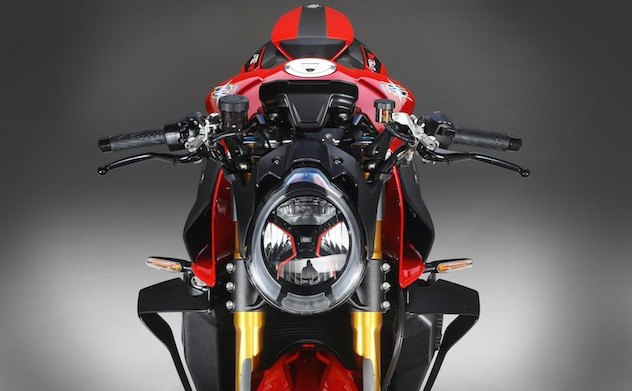
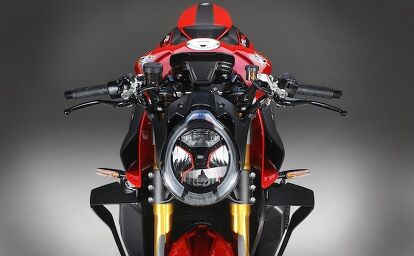































































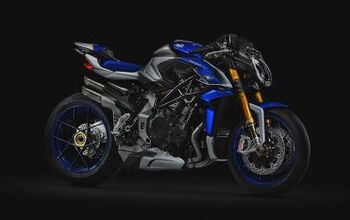





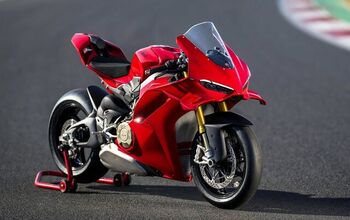




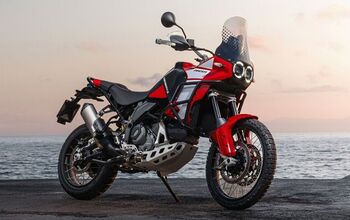




Comments
Join the conversation
Cruise control?!
Like tits on a bull.
All this talk about electric bikes, yet no one saying a word about the MV.....
My question is; With the Serie Oro priced at Unobtanium levels, where does this one fit in? While I enjoy the Italian Art of Motorcycles, I’m not sure I would ever actually own one. MV builds beautiful bikes, just don’t put too many miles on one.....